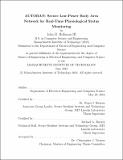| dc.contributor.advisor | Roger I. Khazan and Michael A. Zhivich. | en_US |
| dc.contributor.author | Holliman, John H., III | en_US |
| dc.contributor.other | Massachusetts Institute of Technology. Department of Electrical Engineering and Computer Science. | en_US |
| dc.date.accessioned | 2016-12-22T15:18:27Z | |
| dc.date.available | 2016-12-22T15:18:27Z | |
| dc.date.copyright | 2016 | en_US |
| dc.date.issued | 2016 | en_US |
| dc.identifier.uri | http://hdl.handle.net/1721.1/106010 | |
| dc.description | Thesis: M. Eng., Massachusetts Institute of Technology, Department of Electrical Engineering and Computer Science, 2016. | en_US |
| dc.description | This electronic version was submitted by the student author. The certified thesis is available in the Institute Archives and Special Collections. | en_US |
| dc.description | Cataloged from student-submitted PDF version of thesis. | en_US |
| dc.description | Includes bibliographical references (pages 89-94). | en_US |
| dc.description.abstract | Real-time monitoring of physiological data can reduce the likelihood of injury in noncombat military personnel and first-responders. MIT Lincoln Laboratory is developing a tactical Real-Time Physiological Status Monitoring (RT-PSM) system architecture and reference implementation named OBAN (Open Body Area Network), the purpose of which is to provide an open, government-owned framework for integrating multiple wearable sensors and applications. The OBAN implementation accepts data from various sensors enabling calculation of physiological strain information which may be used by squad leaders or medics to assess the team's health and enhance safety and effectiveness of mission execution. Security in terms of measurement integrity, confidentiality, and authenticity is an area of interest because OBAN system components exchange sensitive data in contested environments. In this thesis, I analyze potential cyber-security threats and their associated risks to a generalized version of the OBAN architecture. Using the threat analysis, I identify security requirements for RT-PSM systems and describe the development of a secure RT-PSM system, called the Authenticated and Trustworthy Open Body Area Network (AUTOBAN) proof-of-concept implementation, that meets those requirements using cryptographic primitives that operate efficiently on low-power embedded devices. The threat analysis and proof-of-concept application, are intended to inform the development of secure RT-PSM architectures and implementations. | en_US |
| dc.description.statementofresponsibility | by John H. Holliman, III. | en_US |
| dc.format.extent | pages | en_US |
| dc.language.iso | eng | en_US |
| dc.publisher | Massachusetts Institute of Technology | en_US |
| dc.rights | M.I.T. theses are protected by copyright. They may be viewed from this source for any purpose, but reproduction or distribution in any format is prohibited without written permission. See provided URL for inquiries about permission. | en_US |
| dc.rights.uri | http://dspace.mit.edu/handle/1721.1/7582 | en_US |
| dc.subject | Electrical Engineering and Computer Science. | en_US |
| dc.title | AUTOBAN : secure low-power body area network for real-time physiological status monitoring | en_US |
| dc.title.alternative | Secure low-power body area network for real-time physiological status monitoring | en_US |
| dc.type | Thesis | en_US |
| dc.description.degree | M. Eng. | en_US |
| dc.contributor.department | Massachusetts Institute of Technology. Department of Electrical Engineering and Computer Science | |
| dc.identifier.oclc | 965799996 | en_US |
